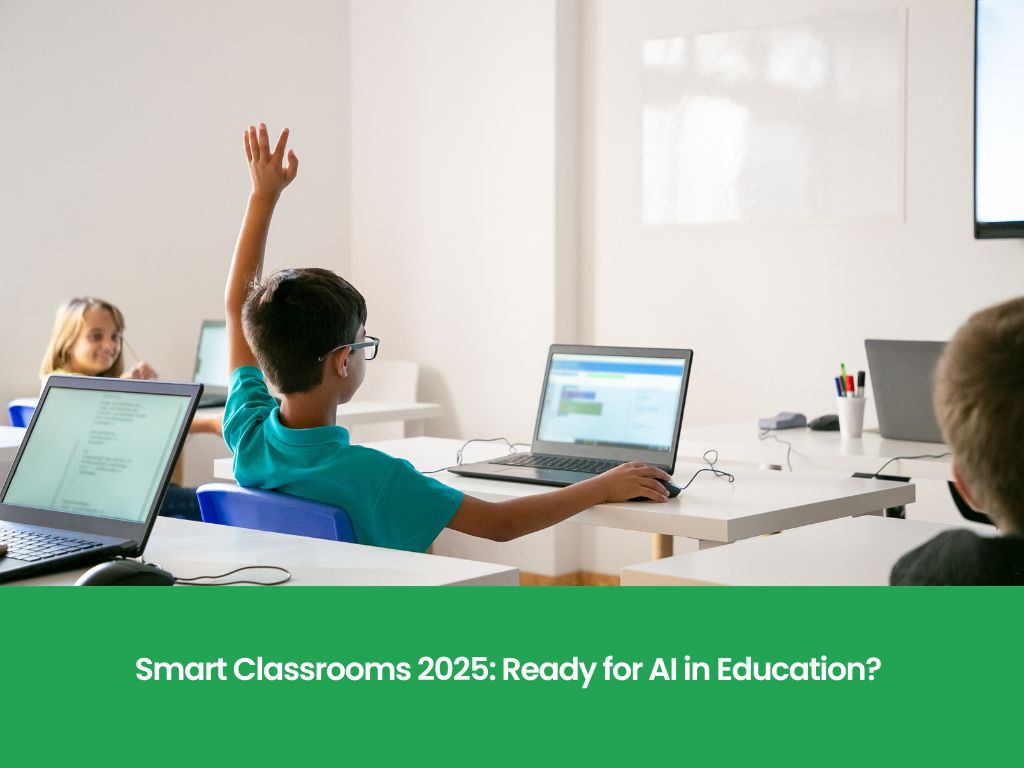Introduction
Step into a classroom in 2025, and the difference is telling. Blackboards are digital screens, notebooks are digital, and artificial intelligence-based tools assist teachers and students. This transformation is a mirror of a fundamental change in the manner of education being delivered, received, and experienced. Smart classrooms are not a trend—there is a sea change in learning design. But since we are at the point of intersection of tradition and innovation, the question that remains is: are we really ready for the AI age of education?
What are Smart Classrooms?
Smart classrooms are not about simply having projectors or computers. Smart classrooms are saturated with cutting-edge technology—interactive whiteboards, machine learning-based attendance and grading systems, VR simulations, real-time analytics dashboards, and cloud-based collaboration tools. The objective is straightforward: to increase the interest, inclusiveness, and efficiency of learning.
In schools such as Gyan Ashram School, being among the Top School in Jaipur, this shift to smart classroom is already well under way. From smart feedback systems to electronic libraries of resources, technology is being utilized to assist teachers and empower students in ways that were hitherto unimaginable.
AI: The Core Engine of Intelligent Classrooms
Artificial Intelligence (AI) has come from being a futuristic dream to an integral part of learning in the present day. AI is not merely assisting with paperwork in 2025—it’s actually defining learning paths.
How AI is Affecting Education
- Personalized Learning Paths: AI platforms can review a student’s learning speed, weaknesses, and learning style to provide them with tailored content.
- Smart Assessment & Feedback: AI can assess performance in real time, giving immediate, constructive feedback.
- Virtual Teaching Assistants: These computer-based programs respond to common questions, suggest resources, and facilitate discussion.
- Predictive Analytics: AI can anticipate future student performance based on historical data, enabling early intervention.
These advancements render education more flexible and student-oriented, and schools that have embraced this revolution are already enjoying the benefits.
The Benefits of Smart Classrooms
- Greater Student Engagement: Interactive classes keep students actively involved and focused.
- Increased Retention Rates: Visual and experiential learning methods enhance memory and understanding.
- Real-Time Collaboration: Cloud platforms allow for group projects even across different geographies.
- Effective Time Management: AI handles routine grading and tracking tasks, freeing up teachers’ time.
For example, in one of the Best Schools in Jaipur, Gyan Ashram School, these technologies are integrated into the curriculum in such a way that the infrastructure is not only technologically equipped but also highly human-oriented.
Problems in Integrating Smart Classrooms
1. Infrastructure Costs
Setting up smart classrooms requires heavy investment in hardware, software, and training. Many rural and underdeveloped schools cannot afford such upgrades.
2. Digital Divide
Not every student has access to a device or stable internet at home, causing learning inequalities.
3. Teacher Training
Technology is only as good as its user. Many teachers are still not adequately trained to utilize AI-based tools effectively.
4. Privacy and Data Protection
Smart systems collect significant amounts of data, making student privacy and information security crucial concerns.
These challenges require government involvement and collaborative action. The silver lining? With awareness and cooperation, they are surmountable.
The Place of Schools in the Era of AI
Schools have a crucial role to play in this revolution of technology. Visionary, willing-to-lead, and proactive schools can take the initiative. AI and the Future of Teaching and Learning will be greatly influenced by how schools want to tap the emerging technologies.
Innovative schools like Gyan Ashram School understand that AI is not arriving to replace teachers—it’s arriving to assist them. It’s a matter of finding the right balance between pedagogy and technology. They stress:
- Seamlessly integrating AI tools into curriculum objectives.
- Providing ongoing professional development to teachers.
- Creating inclusive learning environments.
- Possessing a robust ethical framework of data usage.
In the process, they not only make their students tech-literate but also critical thinkers and good digital citizens.
Are We Really Prepared?
Therefore, are we ready for smart classrooms in 2025 based on AI?
The answer is between optimism and caution. The technology is available. The infrastructure, for the majority of the world, is being built. The schools, the teachers, and the students are growing more ready to try. But to be fully ready, we need to ensure:
- Equitable access to technology
- Systematic teacher training
- In-depth data governance policies
- Inclusive curriculum design
If we are able to tackle those areas, then yes—the education sector will not only be prepped for AI but thrive because of it.
Conclusion
Smart classrooms are no longer a vision for the future—they are here now. With the age of AI in education, how smart we get using these technologies will determine our success. It is not a matter of posting information on the web or plugging in high-tech machines. It’s about changing the way we teach, the way we learn, and the way we grow.
With schools like Gyan Ashram School, one of the Top School in Jaipur, leading the way, we have a strong foundation. These schools teach us that the future of education isn’t just smart—it’s meaningful, personalized, and profoundly human.

